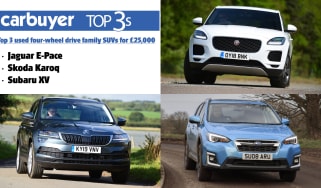Jaguar E-Pace SUV review (2018-2024)
"The Jaguar E-Pace is a stylish SUV with the option of an impressive plug-in hybrid powertrain"
Pros
- Stylish
- Practical
- Efficient plug-in hybrid
Cons
- Heavy
- Firm ride
- Top-spec model is expensive
Making a smaller SUV like the Jaguar E-Pace was an easy decision for Jaguar once it gauged the popularity of the F-Pace. The Jaguar F-Pace may have been the manufacturer’s first SUV but it quickly became its fastest-selling model ever, and the obvious potential in making a smaller, less expensive version, to compete with upmarket rivals such as the Audi Q3, Mercedes GLA, Volvo XC40, Lexus NX, BMW X1, and Volkswagen Tiguan was too good to ignore.
The E-Pace isn’t, however, just a shrunken F-Pace. Sharing its underpinnings with the Range Rover Evoque, the silhouette of the car is noticeably different, with a significantly shorter bonnet. The car is much more influenced by the styling of the Jaguar F-Type sports car, outside and in, even if the rear of the car bears more than a passing resemblance to that of the F-Pace as well.
 Best luxury SUVs to buy in 2025
Best luxury SUVs to buy in 2025
In early 2021, the facelifted E-Pace was introduced. The styling changes were relatively mild but underneath the bodywork, a raft of changes were introduced, including a new platform that’s also used for the latest Range Rover Evoque.
The update also allowed Jaguar to introduce several important enhancements to the E-Pace lineup, including a plug-in hybrid powertrain for the first time, along with new technology like the brand's latest Pivi Pro infotainment system and extra safety features.
The E-Pace range consists of two petrol (P250 and P300) and two diesel (D165 and D200) models, all of which are based on Land Rover’s four-cylinder 2.0-litre Ingenium engines, with power outputs that increase as you ascend the model hierarchy. From its name, you might imagine the E-Pace is electric but the Jaguar I-Pace is actually the company’s battery-powered SUV. From 2021, you can, however, pick a plug-in hybrid (PHEV) version of the E-Pace badged P300e. This has a 15kWh battery, giving it a range of up to 39 miles and potentially slashing running costs, and should make it the most appealing E-Pace for business drivers.
The regular 2.0-litre D165 diesel engine at the bottom of the range is the most economical, capable of up to 45mpg, partly because it’s the only model available with front-wheel drive and a manual gearbox.
Above this base model, every E-Pace is equipped with mild-hybrid electrical assistance, all-wheel drive and an automatic gearbox. Opt for a D165 in this guise and fuel economy drops to around 43mpg.
Our pick of the range is the more powerful D200, which offers greater performance and fuel efficiency, combining its 201bhp with economy of just over 43mpg. If your preference is for petrol, the 246bhp generated by the P250 will be more than adequate, but it will cost significantly more to run than a diesel E-Pace. You’ll struggle to see more than 30mpg from any of the petrols. The P300e PHEV is the economy star, returning an official 141mpg with CO2 emissions of just 44g/km thanks to the helping hand from its electric motor and battery.
The E-Pace is available in three trim levels, which are R-Dynamic, R-Dynamic Black and Sport. It’s well equipped from the off, with LED headlights, 18-inch alloy wheels, a heated windscreen and dual-zone climate control. The R-Dynamic Black Edition trim adds further styling enhancements, including gloss black trim and satin painted alloy wheels, along with a panoramic sunroof. Sport is exclusive to the P300 petrol engine, and includes 21-inch alloy wheels and a Meridian sound system.
The E-Pace is a good car to drive, and while it weighs more than a number of the other cars in its class, such as the Volkswagen Tiguan, the new chassis does a good job of disguising its weight. The interior is smart and surprisingly practical, and the performance on offer doesn’t come at the expense of comfort, even if the car can feel a bit fidgety sometimes, especially on larger alloy wheels.
Our main gripe with the E-Pace used to be its infotainment system, which was sluggish compared to most other systems on the market, but the facelift has also seen big upgrades here. Jaguar has fitted the latest Pivi Pro setup, with an attractive 11.4-inch touchscreen boasting sharp graphics and far quicker responses.
Reliability is somewhat hard to judge. The E-Pace shares parts with the Range Rover Evoque but neither of these cars appeared in the top 75 cars in our 2022 Driver Power ownership survey. It’s concerning that, overall, 40% of Jaguar owners reported a problem within the first year of ownership. Safety won’t be a worry, though, with a stellar five-star score and a huge array of driver assistance features.




















